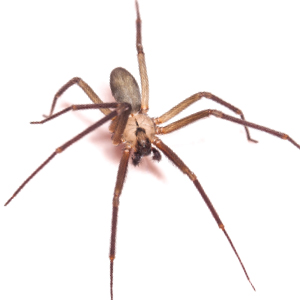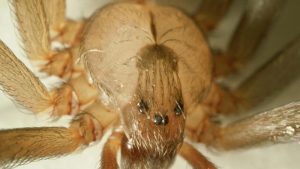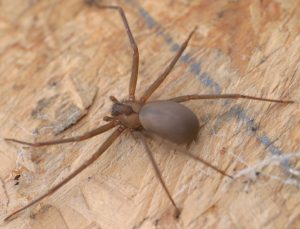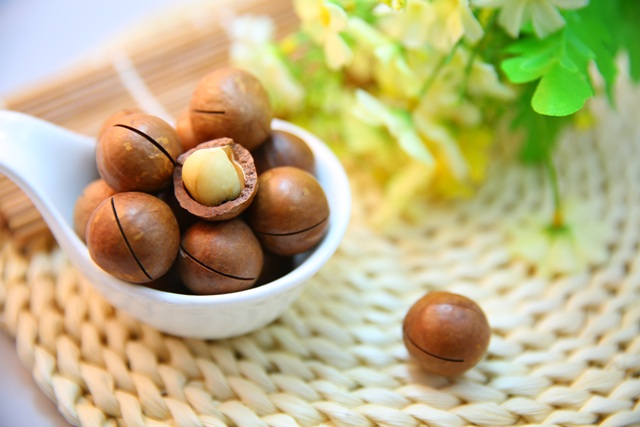Brown recluse spiders (Loxosceles reclusa) are not welcome in any house. They are venomous and their bite may cause a severe swelling, pain, dark urine, fever, vomiting, and tissue breakdown (necrosis) over time.
There are mainly two types of venomous spiders in North America: Brown recluse spider and Black Widow spider.
Many sources claim that brown recluse spiders rarely bite people and are not aggressive, and that they do bite when feel threatened or squeezed accidentally. They are known to have small fangs and cannot easily penetrate the skin. They can bite when smashed to the skin, when putting on clothes with a spider in them, putting on shoes when a spider hides in, and in other similar situations. Some people say they got a bite in their sleep. But do not panic! Most people have lived with them for several years and got a zero bite!
Brown recluse spiders run for cover when disturbed, but may bite out of self defense when they feel trapped. Their bites are generally not fatal, but may lead to tissue necrosis.
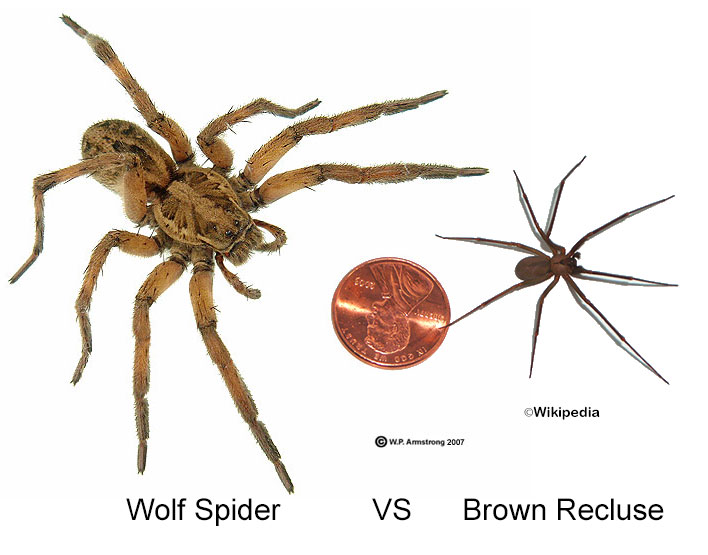
How to identify a Brown Recluse Spider
Look for these signs to identify a brown recluse spider:
- Brown recluse spiders are tan to dark brown with darker violin shape at the center of the body.
- They have 6 eyes, not 8.
- Their size is usually 1/4-1/2 inches long. They can’t grow larger than 1/2 inches (1.3 cm).
- Brown recluse webs are loose and sticky.
- They run really fast.
Where do Brown Recluse Spiders live?
Brown recluses mostly live in some states between the Rocky Mountains and Appalachians. Brown recluse spiders are mostly found in Kansas, Texas, Oklahoma, Arkansas, Louisiana, Missouri, Mississippi, Alabama, Georgia, Tennessee, Kentucky, Ohio, Illinois, Indiana, Iowa and Nebraska. They are pretty dense in Arkansas and Missouri.
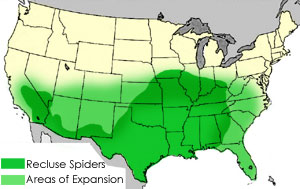
Where do Brown Recluse Spiders hide in the house?
In the house, brown recluses hide in undisturbed places where humans don’t go frequently.
They can be found in such places like:
- Cardboard. They love living in cardboard boxes, because cardboard reminds them the texture of some tree bark they prefer outside.
- Rotting bark
- Closets
- Dark cluttered areas
- Storage boxes in the basement. Check the space under folded cardboard flaps carefully.
- Inside the shoes (yeah, check your shoes before putting them on)
- Clothing, especially if they are on the floor
- Dark corners
- Bedding (bed covers & sheets). Check the bedding before going to bed.
- Clothes lying on the floor.
- Under furniture
- Behind furniture
- Behind books
- Under beds
- In other stored items
- Toilet paper rolls
- Paper towel rack
- In piles of laundry
- Damp areas
- In the walls
- Clutter on the ground or on the flour
- Plywood and tarps on the ground
- Behind pictures
- Sheds
- Barns
- Toilets
How to avoid & eliminate brown recluse spiders?
Common entry points of recluse spiders:
- Air vents
- Gaps under doors
- Gaps beneath siding
How to avoid brown recluse spiders:
- Don’t use bug sprays as they will most likely provide dead bugs for the spiders to eat. Recluse spiders are usually not very sensitive to bug sprays.
- Seal the openings. Caulk around windows and doors. Check around pipes.
- Vacuum often. Vacuum or remove dead insects regularly to remove their meal source.
- Declutter often & keep clean. Clutter is a perfect place for recluse spiders to hide in.
- Use gloves and long sleeves when decluttering the basement, garage, or other cluttered areas. Recluse fangs are so small that they cannot penetrate through a clothing.
- Keep your clothes off the floor and shake them before putting them on.
- Check inside your shoes before putting them on.
- Shake out the clothing and shoes before dressing.
- Check your pockets before sticking your hands in.
- Move the beds away from the wall and keep bed-skirts from touching the floor.
- Store your things in seal-able plastic bags, not in cardboard boxes.
- Do not stack wood against your house. Recluses like woodpiles.
- Keep children away from dark cluttered areas.
How to eliminate brown recluse spiders naturally?
- Use glue traps. Use tack papers, glue boards, glue tunnels, or sticky traps in as many corners of your house as you can. Glue traps are one of the most effective methods of eliminating these spiders. They still can be alive when trapped, so use caution and do not touch them with a bare skin.
- Use food-grade Diatomaceous Earth (D.E.). It is messy, but it is found to be very effective at killing recluse spiders. Diatomaceous Earth is not toxic. It simply dehydrates the insects by causing scratches on their bodies. To reduce the messiness it is best to Diatomaceous Earth with a duster. D.E. does not work when gets wet, but starts working again when dries up.
Natural First Aid for Brown recluse Bites
Brown Recluse spider bite Symptoms
Brown recluse bite may not be intense initially and may be unnoticed for several hours. The bite area becomes red and swollen after about 6-8 hours or earlier. A blister may form at the bite site. A person may have mild to intense pain and itching following the bite. After a week or more, an open ulcer with tissue necrosis (breakdown) develops. The bite is rarely deadly, but may leave an unattractive scar or a hole on the skin if not treated on time.
What to do if you suspect a bite from a recluse spider?
Immediately head to an emergency room to seek proper help.
Until you reach an emergency office, clean the site with soap and water. Apply ice or a cool compress on the bite area every 10 minutes to slow down the venom spread.
What to do if you cannot reach emergency office (away from civilization, for instance)?
I have not used the below methods personally. The below information is based on my research and testimonials of other people that have tried them and had a good success. Be sure to research for yourself before deciding to try them.
- Keep Brown Recluse First-aid Kit at hand and use when in need. (Testimonial from a W.Price Chapter leader)
- Keep Brown Recluse/Hobo Spider Remedy balm in your first aid kit.
- Charcoal poultice method. Mix Activated Charcoal powder with a little water and form a paste. It should not be crumbly, but moist. Spread the paste on a half folded loose woven cloth, a piece of gauze, or a paper towel. Cover the paste by folding over the other half of the cloth or paper towel. Then place this charcoal poultice on the affected area. Cover the poultice with plastic film or plastic food wrap to avoid drying of the poultice. If the poultice dries off, it won’t work. Bandage the poultice securely on place and change every 30 minutes when the bite is fresh or swollen, or several times daily when it starts getting better. Repeat over the course of a week. This method is recognized by emergency room physicians and used to treat different venomous bites from snakes or insects, including brown recluse spiders. You can visit the source of this information to read the testimonials. It is very useful to keep activated charcoal at home for emergency cases like food poisoning or insect bites. (source)
- Charcoal poultice method with extras. Another good remedy to heal the brown recluse bite using activated charcoal, echinacea tincture, turmeric tablets, and colloidal silver. Mix the activated charcoal powder (2-3 capsule size for a fresh bite or a small wound), a few drops (2-3) of Echinacea tincture, a few drops (1-2) of Colloidal silver and form a paste. Place the paste to the gauze or dry paper towel and place the paste side to the wound. Adhere with a saran wrap. Change 3-4 times a day for 3-7 days. When the wound starts to shrink and heal, you can apply the paste overnight only, letting the wound to breathe during a day. Along with topical application, take a Turmeric supplement 2-3 times a day, drink Echinacea tea or a take a daily dose of Echinacea tincture, take 1-2 tsp of Black seed oil every day. (source)
- Cayenne pepper method. Mix a cayenne pepper powder with water keeping it thick. Apply to bite area and cover with a band-aid leaving it for 3 days. Remove band-aid and reapply for another 3 days. Should be gone by then. Some people swear by this method. Good for new bites without ulcers.
- Basil oil and lavender oil method. Clean the wound and apply about 2 drops of basil oil and 4 drops of lavender oil on it. Tape a cotton pad over it. Change this pad 3-4 times daily. Make sure that your oils are therapeutic grade. Take MSM internally and take a high dose of Vitamin C, probiotics. Also drink Basil tea several times a day. (source)
- Other helpful tips and testimonials – “Treatment for Brown recluse spider bite”
